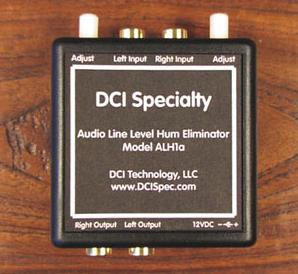|
|||||||||
|
Introduction A ground loop exists when the ground voltage on one component is slightly different than on another component. The difference, say 20 millivolts, travels along the interconnects and gets into the signal path as 60 Hz (50 Hz in Europe) hum. It can be heard in the audio, and seen in the video (purple and green horizontal bars). Often the ground loop can be isolated to one specific component, which may or may not be related to the presence of the ground prong on a grounded plug. Removing the ground plug sometimes reduces the problem, sometimes not, but it can be dangerous to remove the prong, since many components depend on a ground connection to operate properly, and you can also get an electrical shock. A safer way to reduce hum in the audio chain is by use of isolation transformers. The problem with transformers is their restricted bandwidth. The DCI Specialty ALH1 The ALH1, marketed by DCI Specialty, uses active electronic circuits to reduce the hum, rather than transformers. This way, a high bandwidth is maintained. The product works by inserting a varying amount of inverted 60 Hz, up to 2.5 Volts, which cancels the 60 Hz hum. Very, very clever! The ALH1 is a very small unit, with RCA in and out for two channels, adjustable hum control for each channel, and a jack for a 12V DC wall wart. Using the adjustable pots, you turn the control for each channel until the hum is at its lowest level. If you don't turn it far enough, you still have hum. If you turn it too far, the hum comes back. On a recent install of a couch shaker, I had a long RCA cable going from the processor across the room to the amplifier for the shaker. There was considerable hum both in the main audio system and the shaker, as the shaker amplifier was on a different AC circuit than the rest of the equipment, and the voltage was slightly different. So, I inserted the DCI unit between the processor and shaker amplifier, using just one channel of the DCI, adjusted the variable control, and the hum was significantly reduced at the shaker, as well as being eliminated in the rest of the audio system. The small amount of residual hum in the shaker was probably due to the peaks of the generated inverse hum not being exactly in line with the ground loop hum. In any case though, the hum was reduced to almost zero. A second option would be to use one of the new RF transmitter/receivers that let you connect an audio output from the processor to the RF transmitter, with the RF receiver connected to the input on the power amplifier. This completely isolates the processor from the shaker amplifier electrically, not to mention eliminating the need for a long cable run under the carpet. We will report on the RF transmitter/receiver accessories soon. Note that the ALH1 can only be used for audio connections. Its bandwidth is not high enough to be used for composite or component video signals. Conclusions Ground loop hum is a common problem in our multi-component home theater systems, but relief is on the way in the form of the DCI ALH1 Hum Eliminator. It is innovative, inexpensive, and it works.
|
|||||||||




